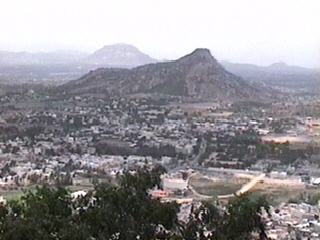Significance: The hill temple
of Subramanyar at Chennimalai, is a hoary shrine associated with colorful
legends. Chennimalai is located 25 km south of Erode in Kongu Naadu and
is known for its association with the Tamil Siddhas (Siddhargal).

Another major hill temple in the area is Tiruchengode,
enshrining Ardhanareeswarar and Chengottuvelavar. Tirumuruganpoondi
is another Saivite shrine in the area, considered to be of great significance to Murugan.
(Pictured above is the view from the Tiruchengode hill temple).
The Chennimalai Murugan temple is built on a hill accessed
through a flight of 1000 steps, and through a motorable road. At the bottom of the hill is
the Kailasanathar temple, which is the scene for the annual festival here.
Legends: This hill is associated with the same legend as the Tiruchengode
hill nearby; a fierce tussle of strength between thewind God Vayu and the serpent king Adi
Seshan resulted in the flying off of a few of the peaks of the Himalayas, one of which is
Chennimalai. It is believed that Vishnu worshipped this sacred hill in Krita
Yugam, when it was then known as Makutagiri, and that it was worshipped
by Lakshmi in Treta Yugam when it was known as Kanakagiri and that it was
worshipped by the Ashta Durgas in Dwapara Yugam when it was known as Pushpagiri. In the
current aeon, it is known as Sirigiri or Chennimalai and
it has been worshipped by Siddhars.
Pinnakku Siddhar, one of the 18 Tamil
Siddhar is believed to have lived here;there is a shrine to him here. There is also a cave
here on the hill, considered to be the abode of Pinnakku Siddhar and this cave is said to
have an underground passage leading to the Bhoga Siddhar
cave in Palani malai.
Legend also has it that two princesses Amritavalli and Sundaravalli
performed penances to be reborn as Valli and Devasena the consorts of Subramanyar.
Deities: The presiding deity here is Subramaniyar, in the form of Dhandayutapani.
The image is an unfinished one.
Legend has it that Shanmukhar was enshrined
here originally and that it was divinely ordained that Dhandayutapani should be installed
and worshipped. An artiste was asked to complete his unfinished image of Dhandayutapani
for this purpose; local legend has it that when he attempt to chisel at the image, blood
gushed out of it and that he was forced to install the image as it was, unfinished below
the waist.
History: This temple is said to have been built by Sivalaya Cholan of the
Kongu Chola clan. It was renovated later by local chieftains in the area.
The hill: The hill is replete with shrines, mandapams and theerthams
(tanks) all associated with interesting legends. Enroute to the main temple are temples to
Indra Vinayakar Senkazhuneer Pillayar and Aadi Vinayakar. Near the Senkazhuneer
Pillayar temple are the Markandeya theertham and the Kumara theertham. There are
also shrines to Kadambavaneswarar, Skanda and Idumban enroute to the main shrine. There is
also a shrine to the guardian deity Malaikkaavalar - Muthukumara Saavan bearing two
swords, in the posture of guarding the hill. There is a tree enroute, known as the Turatti
tree, said to be capable of warding off evil influences.
The temple: The main temple with a single prakaram has shrines to
Subramanyar, Markandeswarar-Imayavalli and
Viswanathar. At the entrance to the temple is a shrine to Vinayakar. In front of the
Subramanyar's sanctum is the
Ardhamandapam, and immediately in front if it is the Mahamandapam.
The Mahamandapam enshrines a festival image of
Subramanyar facing south. The sanctum faces east. The sanctum to Markandeswarar enshrines
Shiva facing east and
Imayavalli facing south. The sanctum to Viswanathar enshrines Shiva, and the ardhamandapam
in front of it enshrines his consort Visalakshi facing south.
There are steps leading to the Valli-Deivayanai shrine from behind this temple. Behind the
Vali Deivayanai shrine is siddhar shrine mentioned above. Valli and Deivayanai are
enshrined without their consort Murugan, symbolizing the legend mentioned above.
Festivals: Seven worship services are offered each day here. Kartikai
asterism and new moon days in each month attract
several here. The annual festival is celebrated at the Kailasanathar temple at the bottom
of the hill in the month of Thai.

